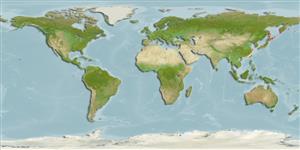Potamocorbula amurensis (Schrenck, 1861)
Brackish-water corbula| Native range | All suitable habitat | Point map | Year 2050 |

|
| This map was computer-generated and has not yet been reviewed. |
| Potamocorbula amurensis AquaMaps Data sources: GBIF OBIS |
Google image | No image available for this species;
drawing shows typical species in Corbulidae.
Classification / Names Common names | Synonyms | CoL | ITIS | WoRMS
Bivalvia | Myida | Corbulidae
Environment: milieu / climate zone / depth range / distribution range Ecology
Benthic; brackish. Temperate
Distribution Countries | FAO areas | Ecosystems | Occurrences | Introductions
Pacific Ocean: China, Japan and Korea.
Length at first maturity / Size / Weight / Age
Maturity: Lm ? range ? - ? cmCommon length : 2.5 cm DL male/unsexed; (Ref. 3161)
Life cycle and mating behavior Maturity | Reproduction | Spawning | Eggs | Fecundity | Larvae
Main reference
References | Coordinator | Collaborators
Cohen, A.N. and J.T. Carlton 1995 Biological study. Nonindigenous aquatic species in a United States estuary: A case study of the Biological invasions of the San Francisco Bay and Delta. Report for the United States Fish and Wildlife Service and the National Sea Grant Program, Conneticut Sea Grant Publication PB96-166525, Washington, DC. (Ref. 3166)
IUCN Red List Status
(Ref. 130435: Version 2025-1)
CITES status (Ref. 108899)
CMS (Ref. 116361)
Threat to humans
Human uses
| FishSource |
Tools
More information
Diet composition
Food consumption
Predators
Max. ages / sizes
Length-weight rel.
Length-length rel.
Length-frequencies
Mass conversion
Abundance
Internet sources
BHL | BOLD Systems | CISTI | DiscoverLife | FAO(Publication : search) | Fishipedia | GenBank (genome, nucleotide) | GloBI | Gomexsi | Google Books | Google Scholar | Google | PubMed | Tree of Life | Wikipedia (Go, Search) | Zoological Record



